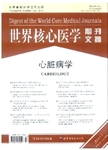对晚期慢性心力衰竭患者行心脏再同步化治疗致NYHA分级改善的临床预测因素和时机:多中心InSync随机临床评价(MIRACLE)和多中心InSyncICD随机临床评价(MIRACLE-ICD)试验的结果
Clinical predictors and timing of New York Heart Association class improvement with cardiac resynchronization therapy in patients with advanced chronic heart failure:Results from the Multicenter InSync Randomized Clinical Evaluation(MIRACLE) and Multicent作者机构:Heart Rhythm CenterSt.John Hospital and Medical Center22101 Moross RdDetroitMI 48236United StatesDr
出 版 物:《世界核心医学期刊文摘(心脏病学分册)》 (Digest of the World Core Medical Journals(Cardiology))
年 卷 期:2006年第2卷第9期
页 面:13-13页
学科分类:1002[医学-临床医学] 100201[医学-内科学(含:心血管病、血液病、呼吸系病、消化系病、内分泌与代谢病、肾病、风湿病、传染病)] 10[医学]
主 题:心脏再同步化治疗 慢性心力衰竭患者 NYHA分级 晚期心力衰竭 预测因素 InSync 随机分配 D试验
摘 要:Background: Based on current patient selection criteria, a significant proportion of recipients of cardiac resynchronization therapy(CRT) do not respond to treatment. The purpose of this analysis is to identify predictors and characterize the timing of response to CRT in patients with advanced heart failure. Methods: Patients randomized to receive CRT in the MIRACLE and MIRACLE-ICD trials, designed to assess the benefit of CRT compared with standard medical therapy in patients with advanced heart failure, left ventricular ejection fraction 0.35, and QRS ≥130 milliseconds, were included for this analysis. Patients with an improvement of ≥1 New York Heart Association(NYHA)class from baseline to the 6-month follow-up were considered responders and those who had no change or worse NYHA class or died were classified as nonresponders. Responders were subdivided into early(within 1-3 months) and late(6 months). Results: One hundred forty-three(64%) of 224 and 190(61%) of 313 patients in the MIRACLE and MIRACLEICD trials, respectively, responded to therapy, with 81(57%) of 143 and 100(53%) of 190 responding early. Several but differing factors predicted CRT response and timing in the two trials with a high sensitivity(89%-90%) but, owing to a low specificity(31%-49%), a modest predictive accuracy(66%-75%). Conclusions: Based on improvement of ≥1 NYHA class, less than two thirds of patients enrolled in the MIRACLE or MIRACLE-ICD trials responded to CRT, with just more than half responding within the first month. Several factors predicted CRT response and timing, but given their modest predictive accuracy, comparable for both studies, additional methods for selecting candidates most likely to benefit from CRT are needed.



